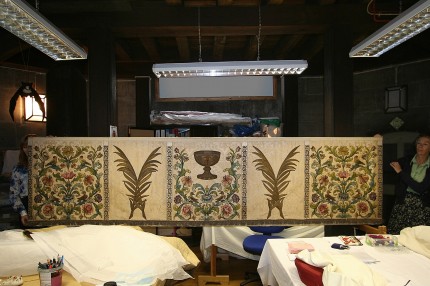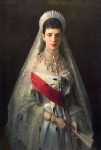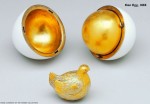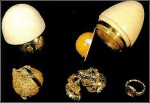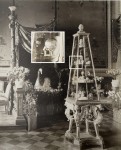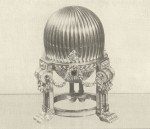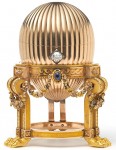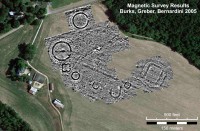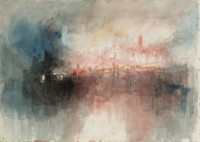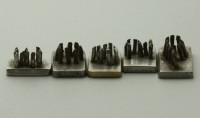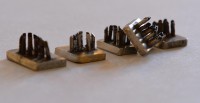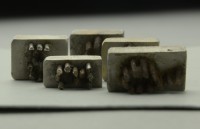
An altar frontal that was hand embroidered by 133 soldiers as they recovered from their injuries during World War I will be going back on display at St. Paul’s Cathedral in London for the first time in 70 years. Commonwealth soldiers from the UK, Australia, Canada, New Zealand and South Africa convalescing at hospitals all over Britain contributed to the altarpiece, embroidering sections of five panels which were then stitched together by experts at the Royal School of Needlework. The final product is almost 10 feet wide and features intricate floral patterns alternating with two palm branches, signifying martyrdom’s spiritual victory over the flesh. The central panel is the chalice of the Eucharist, representing Christ’s suffering for the forgiveness of sin, above a floral field.
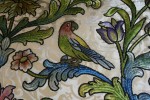 The altar cloth was organized by the Royal School of Needlework as a form of occupational therapy for recovering soldiers. Occupational therapy, the idea that working could be physically and psychologically beneficial for trauma patients, began during World War I as treatment for shellshocked and injured soldiers. Patients learned arts and crafts like basket weaving and painting and, if they were physically able, heavier skills like woodwork and welding. For the war wounded, “lap crafts,” work that could be done while seated, were particularly useful, and embroidery, cross-stitching and other needlework coupled the convenience of a lap craft with the development of fine motor skills and coordination invaluable to men with limb injuries and the painful ticks and tremors of shell shock. Sewing was both physical therapy and a welcome distraction from their suffering. It didn’t require the use of heavy machinery or tools, nor even a workbench. Wounded men could stitch while sitting comfortably in bed.
The altar cloth was organized by the Royal School of Needlework as a form of occupational therapy for recovering soldiers. Occupational therapy, the idea that working could be physically and psychologically beneficial for trauma patients, began during World War I as treatment for shellshocked and injured soldiers. Patients learned arts and crafts like basket weaving and painting and, if they were physically able, heavier skills like woodwork and welding. For the war wounded, “lap crafts,” work that could be done while seated, were particularly useful, and embroidery, cross-stitching and other needlework coupled the convenience of a lap craft with the development of fine motor skills and coordination invaluable to men with limb injuries and the painful ticks and tremors of shell shock. Sewing was both physical therapy and a welcome distraction from their suffering. It didn’t require the use of heavy machinery or tools, nor even a workbench. Wounded men could stitch while sitting comfortably in bed.
Needlework also had the marked advantage of a wide pool of potential teachers, thanks to the army of women on the homefront who volunteered for the Red Cross or local organizations like the Khaki Club in Bradford which deployed embroidery master Louisa Pesel to help a group of soldiers recovering at the Abram Peel Hospital in Leeds to cross-stitch an altar frontal of their own for use at the hospital chapel.
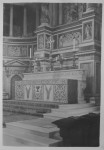 The final stage of stitching together the panels of St. Paul’s altar cloth was completed after the war ended. The finished product was then presented to St. Paul’s Cathedral where for decades it graced the front of the cathedral’s high altar. It was removed for its own safety after St. Paul’s was hit by German bombs during the Blitz. One bomb dropped in October of 1940 was a direct hit, obliterating the altar. You can see the aftermath of another bombing in 1941 in this silent footage from British Pathé.
The final stage of stitching together the panels of St. Paul’s altar cloth was completed after the war ended. The finished product was then presented to St. Paul’s Cathedral where for decades it graced the front of the cathedral’s high altar. It was removed for its own safety after St. Paul’s was hit by German bombs during the Blitz. One bomb dropped in October of 1940 was a direct hit, obliterating the altar. You can see the aftermath of another bombing in 1941 in this silent footage from British Pathé.
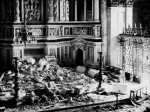 When the war was over and the high altar rebuilt, its dimensions were different so the World War I frontal no longer fit. It was kept in a chest for more than 70 years until the cathedral decided to conserve it for display on the centenary of the beginning of World War I. The frontal is now being restored by the cathedral’s borderers (embroiderers and members of the medieval guild which still exists today). When the repair work is done, the textile will be used for the first time since World War II at a special service on August 3rd, 2014, the hundredth anniversary of the day Germany declared war on France and began an invasion through neutral Belgium triggering Britain’s entry in the war. After that, it will be go on display in a dedicated space in the cathedral for four years until the centenary of armistice.
When the war was over and the high altar rebuilt, its dimensions were different so the World War I frontal no longer fit. It was kept in a chest for more than 70 years until the cathedral decided to conserve it for display on the centenary of the beginning of World War I. The frontal is now being restored by the cathedral’s borderers (embroiderers and members of the medieval guild which still exists today). When the repair work is done, the textile will be used for the first time since World War II at a special service on August 3rd, 2014, the hundredth anniversary of the day Germany declared war on France and began an invasion through neutral Belgium triggering Britain’s entry in the war. After that, it will be go on display in a dedicated space in the cathedral for four years until the centenary of armistice.
To pay tribute to the 133 soldiers who contributed to the altar frontal, St. Paul’s officials would like relatives of the men to contact them. They’re hoping photographs, letters, mementos, family stories can be included in the display to give visitors a more personal understanding of the soldiers’ lives. Researchers have compiled a complete list of their names, ranks, regiments and the hospitals they were staying at when they worked on the frontal. Here is the complete list in an Excel spreadsheet. If you have relatives who fought for Britain in World War I and were hospitalized there, do check the list. If you see a name you recognize, contact the Reverend Canon Michael Hampel at precentor@stpaulscathedral.org.uk.
